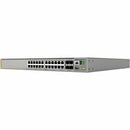Description
Engineered for modern enterprise networks, the Allied Telesis x530-28GPXm Layer 3 Switch delivers a powerful blend of dense port density, flexible uplinks, and robust routing features in a compact 1U form factor. With 24 Gigabit Ethernet ports and 4 x 10 Gigabit uplinks, it offers quiet access-layer connectivity while providing high-speed interconnectivity to distribution and core layers. Built-in stacking simplifies growth and centralized management, making it an ideal choice for campuses, branch networks, and data-center edge deployments that demand reliability, security, and scalable performance. This switch is designed to balance performance, manageability, and security in a single, easy-to-deploy platform that grows with your organization.
- High-Density Access and Flexible Topology: 24 x 1G ports for end-user devices and 4 x 10G uplinks (SFP+) for rapid aggregation to distribution or core switches, enabling scalable network layouts in a compact 1U chassis.
- Layer 3 Routing and Redundancy: IPv4/IPv6 routing with static and dynamic routing options (OSPF), plus VRRP for gateway redundancy to ensure continuous availability and efficient failover across devices.
- Advanced Security and Segmentation: ACLs, VLAN tagging with 802.1Q, and robust segmentation features that help isolate departments or guest networks while maintaining centralized policy control.
- Quality of Service and Traffic Management: Multi-queue prioritization, DSCP tagging, and 802.1p-based prioritization to guarantee performance for real-time applications like voice and video, as well as critical business workloads under congestion.
- Simple Management and Scalable Growth: Web-based management and CLI provide flexible administration, with stacking capabilities that allow multiple switches to operate as a single logical device for centralized configuration and uniform policies.
Technical Details of Allied Telesis x530-28GPXm Layer 3 Switch
The Allied Telesis x530-28GPXm is designed to deliver reliable enterprise performance in a compact 1U chassis. It combines a dense port footprint with flexible uplinks and rich Layer 3 features that support growing networks. The following specifications summarize its core capabilities and networking power, enabling IT teams to deploy scalable solutions without compromise:
- Ports: 24 x 1 Gigabit Ethernet ports plus 4 x 10 Gigabit uplinks (SFP+), delivering abundant access-layer connections and high-speed aggregation options to meet evolving network demands.
- Layer 3 features: IPv4 and IPv6 routing, static routing, and dynamic routing support (e.g., OSPF), with VRRP for gateway redundancy and reliable failover between devices.
- Networking capabilities: VLAN support with 802.1Q tagging, enabling flexible network segmentation and trunking between access and distribution layers for scalable multi-tenant or departmental networks.
- Security and policy: ACLs and policy-based controls to enforce security boundaries and protect sensitive data flows across the campus or data-center edge.
- Quality of Service: Multi-queue prioritization, DSCP tagging, and 802.1p-based class of service to ensure predictable performance for voice, video, and mission-critical applications during peak traffic.
- Management and scalability: Web-based management and CLI, plus stacking so multiple switches can operate as a single logical device with centralized configuration and uniform policies across devices.
- Form factor and environment: 1U chassis designed for enterprise racks, balancing footprint with ample port density and cooling efficiency to fit in standard data-center or wired-branch environments.
How to Install Allied Telesis x530-28GPXm
- Prepare the installation site: choose a well-ventilated, temperature-controlled rack space in a standard 19-inch rack, ensuring there’s enough clearance for rear cabling and airflow around the 1U switch.
- Mount and power: secure the x530-28GPXm in the rack, connect to a reliable power source, and verify power-on indicators to confirm the unit is operating correctly.
- Connect network devices: attach devices to the 24 x 1G ports for access-layer connectivity and connect the 4 x 10G uplinks to distribution or core switches using appropriate SFP+ modules and fiber or copper cables as required.
- Access the management interface: connect a management workstation to the switch and launch the web-based GUI or access the CLI through the console port to begin configuration.
- Configure core settings: assign a management IP address, create VLANs with 802.1Q tagging, configure trunk ports for uplinks, enable IPv4/IPv6 routing with static routes or OSPF, and set up VRRP for gateway redundancy. Apply QoS policies, as needed, and implement ACLs to enforce security boundaries. Save, verify, and monitor status to ensure optimal performance.
Frequently Asked Questions
-
Q: How many ports does the Allied Telesis x530-28GPXm provide?
A: It offers 24 x 1 Gigabit Ethernet ports for end-user devices and 4 x 10 Gigabit uplinks (SFP+), enabling high-speed connections and scalable aggregation. -
Q: Does this switch support Layer 3 routing?
A: Yes. It includes IPv4 and IPv6 routing, static routing, dynamic routing options such as OSPF, and VRRP for gateway redundancy. -
Q: Can multiple switches be stacked?
A: Yes. The x530-28GPXm supports stacking to form a single, manageable logical switch with centralized configuration and uniform policies. -
Q: Is PoE supported on end-user ports?
A: PoE capability is not specified in the provided product details. If you require PoE, confirm the exact model revision or datasheet for PoE support. -
Q: What management interfaces are available?
A: The switch can be managed via a web-based interface or the command-line interface (CLI) for robust configuration and monitoring.
Customer reviews
Showing - Of Reviews


